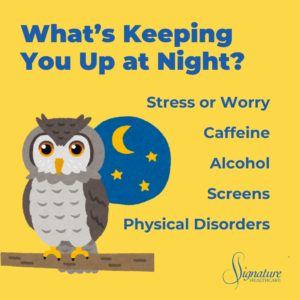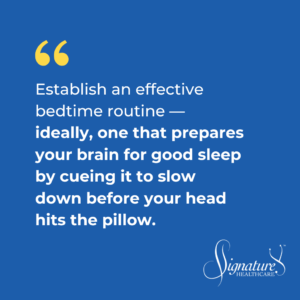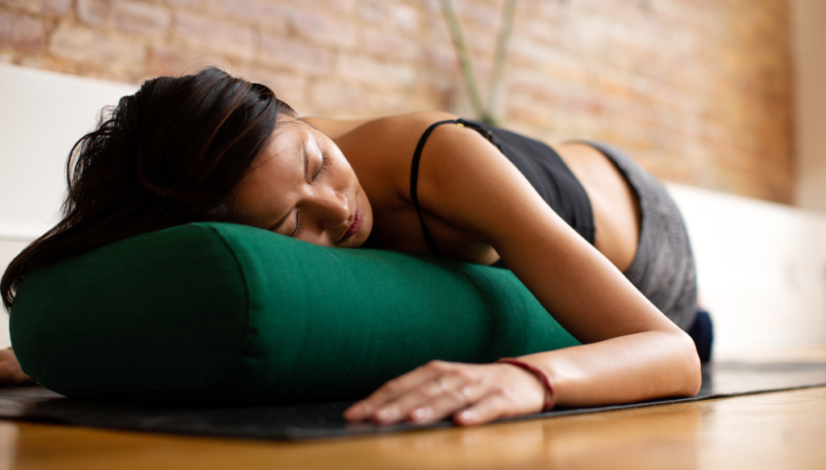Try Yoga Nidra for a Good Night’s Sleep
As a concierge physician and a yoga aficionado for over a decade, supporting and encouraging wellness is in my nature.
Thanks to my yoga training, I’ve particularly come to appreciate how yoga improves our lives: it alleviates arthritis and back pain, improves balance and flexibility, and reduces stress and inflammation, just to name a few.
During the COVID-19 pandemic, with the general population quarantined, I practiced yoga daily at home, eventually developing a full routine focused on flexibility, balance, strength, and meditation.
I also completed 200 hours of comprehensive yogic training and a workshop in adaptive yoga. Post-pandemic, this expertise complements my medical training by helping patients relieve pain, improve mobility, decrease the risk of falls… and, yes, sleep better.

What’s Keeping You Up at Night?
A good night’s sleep is a pillar of excellent health.
We spend about one-third of our lives sleeping — or at least trying to sleep. Most people function well with seven to nine hours of sleep. Some get by with five or six; others may need as many as 10.
However, sleep patterns and needs vary for everyone and change over time. We all go through phases where we struggle to fall asleep and stay asleep.
Sleep troubles are rarely straightforward, so discussing sleeplessness with your doctor is important. Many factors can disrupt the amount and quality of sleep you get, including:
- Stress or worry: This is the most common sleep barrier my patients face. Problems that are small by day seem to magnify when we lie awake in the dark.
- Caffeine: Caffeine ingested within eight hours of bedtime disturbs sleep cycles.
- Alcohol: One or two servings of alcohol may enable you to fall asleep, but it often causes you to wake up — and stay awake — in the middle of the night.
- Screens: If you watch TV or use a cellphone or computer before bedtime, the screens’ blue light may affect your sleep patterns.
- Physical disorders: Medical conditions and complaints — such as anxiety disorder, sleep apnea, restless leg syndrome, menopausal shifts, or an overactive bladder — hinder your peaceful rest.
Your concierge physician knows it’s important to diagnose what’s causing your sleeplessness (often a combination of factors) and find a solution for you.
How to Fall (and Stay!) Asleep
Our brains go 100 mph during the day, and it’s unrealistic to expect the brain to instantly shut down and take us into a deep slumber at night. And we know that the brain remains active in sleep, dreaming and processing information.
To transition into those active sleep stages, establish an effective bedtime routine — ideally, one that prepares your brain for good sleep by cueing it to slow down before your head hits the pillow. These best practices can help:
- Go to bed and wake up at the same time each day, even on weekends and holidays.
- Avoid activities that overstimulate your brain before bedtime, such as tackling a stressful work project or discussing a difficult topic with a family member.
- Minimize ambient noise or light to make your bedroom space conducive to sleep.
- Read or listen to relaxing music.
- Practice calming yoga techniques before you retire for the night.

Yoga Nidra at Bedtime
Yoga provides flow sequences and breathing exercises that lead to restful sleep.
In fact, a branch of yoga known as yoga nidra (yogic sleep) calms your brain and induces slumber. It reduces stress, helps tight muscles unwind, slows digestion, and creates a relaxed state.
Yoga nidra is typically a guided meditation. Your guide takes you through a full-body scan, progressively relaxing each part of your body from head to toe (or toe to head).
In a philosophical sense, the scan focuses on the body’s chakras, or energy sources. It brings awareness to your breath, body areas that need more attention, and recently surfaced emotions. There are no long periods of silence that let your brain wander toward rehashing the day’s events.
Yoga nidra is suitable for just about anyone. No movement is involved. You’ll typically recline in a restful pose (savasana, or corpse pose). You can practice yoga nidra in your bed, on a chair, or on a couch.
Search for yoga nidra on YouTube, Spotify, or iTunes. Experiment with different versions and formats to find your favorite.
There’s no wrong way to do it — whatever works for you is the right way. You’ll benefit from yoga nidra whether you practice it for five minutes or 45 minutes.
And if you fall asleep during your practice, congratulations! You’ve found the fountain of youth: a deep, restorative night’s sleep.
Get the Sleep You Need
I love that everyone of any physical ability can practice yoga nidra and other forms of yoga. It’s easy to do at home.
Yoga poses have many adaptations, so you can push yourself or modify the poses to suit your body’s needs if you’re having a particularly challenging day. Yoga builds strength, balance, endurance, cardiovascular health, and mental focus — and it will help you sleep!
Having trouble nodding off at bedtime? A conversation with your Signature Healthcare physician can help you find the answers.
We uncover the factors behind your sleepless nights and help you achieve the restful, healthy slumber you deserve. Give us a call to chat.

Dr. Ameesha Pandya
Dr. Ameesha Pandya Kansupada, MD, a board-certified Internal Medicine specialist and Fellow of the American College of Physicians, brings over 27 years of diverse medical experience, ranging from hospital to outpatient care. Passionate about holistic health, she combines her medical expertise with yoga instruction and culinary medicine, while enjoying travel, walks, and cooking in her personal time.
Get the latest News
Join the Signature Healthcare Newsletter to get the latest articles, resources, and news delivered directly to your inbox.

